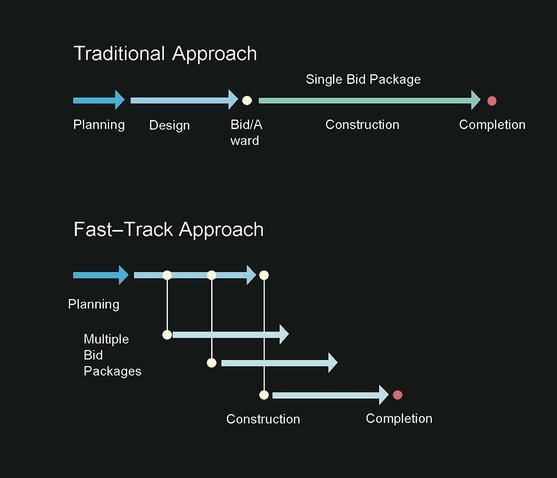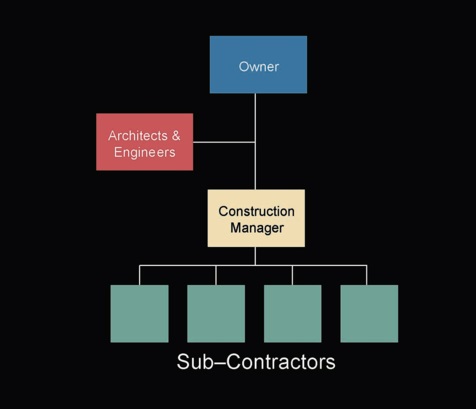Construction Phase
 |
Project Schedule Comparison |
The construction process enables all of the planning and design documentation to be realized in an actual building. There are several methods, or construction models:
Traditional Construction
The most common construction process is "design-bid-build". A governing body hires an architect to plan and design a courthouse, construction documents are prepared by the architect, construction bids are received from contractors, a contractor is selected, and the courthouse is built. In the traditional design-bid-build development process, a project has five distinct phases. To learn more, click to select a phase of thecourthouse construction process.
Fast-Track Construction
Unlike traditional design-bid-build development, "Fast-Track" construction allows construction to begin before the design is completed. Engineers and architects stay one step ahead of the builder, condensing the time required to complete the project. A construction manager may be employed in any variation of traditional or "fast track" construction project. The CM acts as a construction consultant during the design phase, providing expertise on construction, scheduling, and costs. The CM may continue as a consultant to the owner during the construction phase, or may become the contractor.
The complex process and the myriad contractual relationships in the construction of a courthouse have nearly infinite variations. Each owner must determine which project organization is best for the project at hand. Knowledgeable staff and consultants, economic constraints, and scheduling requirements are all important in determining the best process. Most important, the owner needs to have clearly stated goals and to understand how the chosen process will help achieve those goals.
Construction Administration
Assembling diverse materials into a final product is a complicated process. Because so many things happen simultaneously, and as so many of the construction elements are interdependent, careful management is absolutely critical.
 |
Traditional Management Approach |
Construction management, whether provided by a general contractor (GC) or a construction manager (CM) hired by the client, coordinates materials, equipment, personnel, subcontractors, inspections, schedule, and budget to complete the building in accordance with the construction documents. The GC or CM also obtains all permits and ensures compliance with all regulatory agency requirements.
The design team and the client both have essential roles during the construction phase. The contractor will prepare submittals and shop drawings for review and approval by the design team and the client. A timely review of these submittals and drawings is important because actual materials being supplied are compared with those specified in the design documents.
Change Orders
Change orders are part of this phase even though every effort is made to minimize them. Unforeseeable conditions, such as unusual soil conditions, may be discovered during excavation or construction. Functional elements, such as court jurisdiction or the number and responsibility of staff, may change, and changes may develop from ambiguity in the documents. Change order requests are reviewed by the design team and, if approved by the client, prepared and issued as design changes. The cost and schedule are adjusted accordingly. It is important to fix responsibility for initiating and approving change orders, as they can result in considerable costs to the project. While many change orders are likely to be initiated by the court or other users of the facility, the owner (county or city) and the committee should be involved to ensure that changes do not threaten the project budget or jeopardize other areas of the design.
Project Close-Out
At the completion of construction, the project is inspected by the design team, the review and advisory committee, and the client for compliance with the design and for substantial completion. A list of items the contractor must complete is developed. Project closeout requirements are monitored. If desired, record drawings (as-built drawings) are prepared by the design team. These drawings are based on information provided by the contractor and provide a record of how the building was actually constructed.
The owner will usually occupy the building upon a determination that the project is substantially complete; that is, when the building is complete to the point of being usable. Substantial completion certificates and occupancy permits may be issued with some items outstanding. At final completion, all such items should be finished, and final payments should be made to the contractor only after the contractor's surety has given consent.